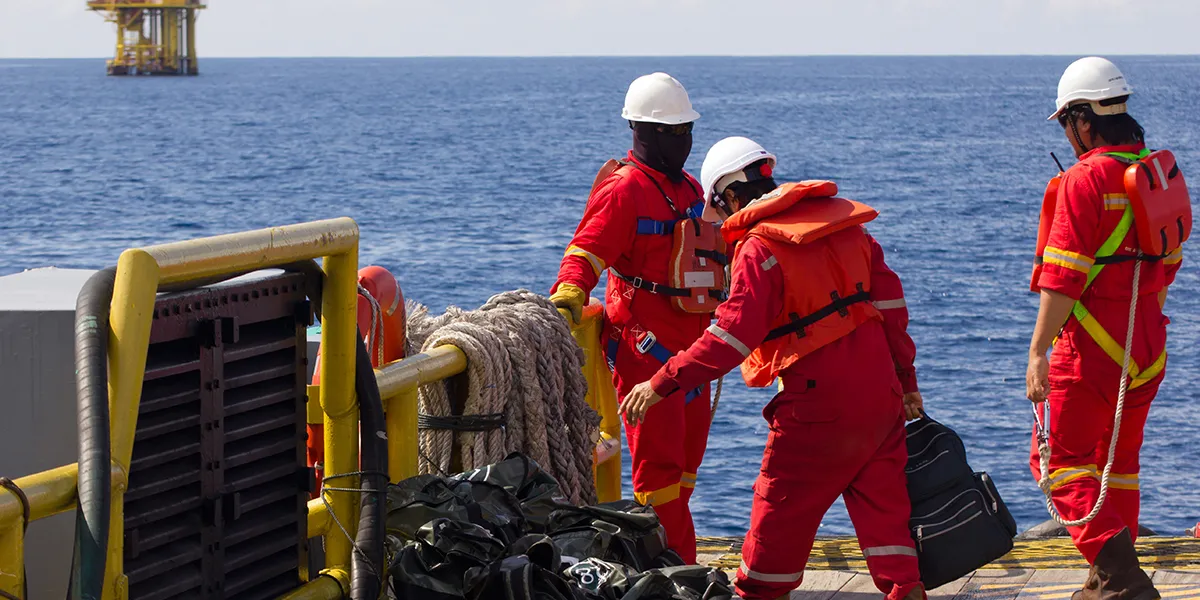Battling Heat Stress in Unconventional Workspaces

Extreme heat events are becoming more frequent and severe, with 2023 being the hottest on record. For some workers, this poses a real health risk and, in some cases, may be fatal.
While the dangers are well-documented for professions like metal manufacturing, firefighting, and oil and gas, the impact of heat on other professions is less known.
This article delves into the impact of heat stress on some less apparent professions — from mascots to lifeguards — and provides actionable insights for employers to safeguard their workers.
- What is a heat-related illness?
- Who is at risk of heat-related illnesses?
- Lifeguards: Guardians of the beach but victims of the heat
- Fishing: Catching more than one type of ray
- Park rangers: Stewards of the wilderness under threat
- Mascots and entertainers: The heat behind the cute costumes
- Mass gatherings: Heat taking its toll on sporting and music events
- Couriers: The hidden risks of heat on the road
- Minimizing the risk of heat stress
- Conclusion
What is a heat-related illness?
The human body maintains a core body temperature (CBT) between 36.5°C / 97.7°F and 37.5°C / 99.5°F. Overheating, caused by prolonged exposure to high temperatures and being unable to cool down effectively, can lead to heat-related illnesses like heat stroke. Dehydration can set in, seriously affecting a worker’s health and ability to function safely. Exposure to high temperatures can impair balance, coordination, and cognition, increasing the risk of occupational accidents.
If CBT continues to rise, heat exhaustion can set in, presenting symptoms like nausea, increased heart rate, and rapid breathing. In severe cases, when CBT exceeds 40°C / 104°F, heat stroke can occur, leading to seizures, vomiting, multiple organ failure, and even death.
Heat-related illnesses are progressive and potentially life-threatening if not addressed early. Fortunately, if it is recognised and treated early, emergencies can be prevented. You can read a more in-depth overview of heat stress here.
Who is at risk of heat-related illnesses?
Everyone is at risk of heat injury – especially those who spend much of their day outside in high temperatures. There are also many factors that can increase the risks. Heat affects people differently, depending on overall well-being, metabolic health, age, sex, sweat response, acclimatization, etc.
While many countries set minimum temperatures for work environments (usually at least 16˚C / 61˚F, or 13˚C / 55˚F if the work involves a lot of physical effort, according to the Health and Safety Executive), guidelines for upper-temperature limits are often less specific. Even so, it becomes challenging to control temperatures for outside workers, and employers are ever more aware of their duty of care to employees working in the heat.
Some working environments more obviously expose people to risk – think firefighters, oil and gas workers, miners, coal workers, etc. But heat impacts those in perhaps more inconspicuous professions, too. Here are just a few examples.
Lifeguards: Guardians of the beach but victims of the heat
It’s not just beach and pool-goers who are in danger of heat stress — the lifeguards who protect them are, too. While operating in direct sunlight is risky enough, the sun’s reflections from large bodies of water, land and rocks, and metal surfaces (such as observation towers and boats) amplify that risk.
Lifeguards working in Saudi Arabia, where temperatures can top 50°C / 122°F, have reported taking stringent measures to cope. One lifeguard working an eight-hour shift patrolling the water on a jet ski or the beach on foot said her colleagues cooperate and swap in if one gets tired since fatigue is a symptom of heat stress.
Lifeguards, in particular, can be physically active, for example, by patrolling an area or responding to an emergency. This physical exertion can exacerbate heat stress by causing dehydration, raising body temperature, and decreasing blood volume, all of which reduce heat loss from the body.
Heat can also impair cognitive performance. Evidence suggests that acute heat stress affects cognitive processing when environmental temperatures exceed 23°C / 73.4°F and core body temperature exceeds 39°C / 102.2°F. This is important for lifeguards since they require mental clarity to be constantly vigilant and monitor for danger — especially in the summer when there are more people around.
Fishing: Catching more than one type of ray
Already a hazardous industry, fishermen face increasing risks from increasing temperatures. They endure extreme sun, reflected heat from the sea and boats, strenuous work and long hours, exposing them to significant risk of, often severe, heat-related illnesses. The National Institute of Occupational Safety and Health (NIOSH) reported a 2022 study using California state-wide workers’ compensation data, identifying agriculture, forestry, fishing, and hunting as having many heat-related illnesses.
In May 2023, a fisherman in India suffered multi-organ complications (including kidneys, heart, brain and vision) from heat stroke after five consecutive days at sea. This was reported as one of the most severe occurrences of heat stroke and heat exhaustion within India’s fishing community in recent months.
Park rangers: Stewards of the wilderness under threat
National Parks worldwide have been experiencing the effects of climate change over the last few years. Deadly wildfires have burnt thousands of hectares of bush in Australia, and extreme heat has forced parks like Yosemite to close to visitors. City parks present different challenges since atmospheric conditions can trap pollutants, which in turn trap heat.
There are broader risks for park rangers. For instance, heat stress is particularly challenging in areas where it is difficult to access clean drinking water for hydration. In addition to this, their work is often physical in extremely remote areas and in small teams. Research has shown rangers performing high physical workloads in high temperatures can experience heat stress and heat-related symptoms, such as dehydration, fatigue, nausea, dizziness, light-headedness, and impaired judgment.
In the USA, the National Parks Service requires every park to establish a system to assess heat stress, alert employees of increased risk of heat strain, and implement control measures adequate to prevent heat-strain injuries.
Mascots and entertainers: The heat behind the cute costumes
Whether greeting visitors at Disneyland or jeering up a crowd at a sports match, mascot performers are high-energy entertainers who regularly work in the intense heat of the day. The nature of the bulky, heavy and often furry costumes make it the perfect conditions to trap the heat, making it extremely hot.
Little research has been published into mascot-related heat stress. However, a small study found that 28 out of 48 mascot users reported severe heat-related injuries, such as heat exhaustion and heat stroke. The researchers concluded that heat-related illnesses resulting from the use of mascots are the most severe health problems among mascot wearers.
These heat-related injuries have occurred even where outdoor temperatures are relatively low. In July 2019, a mascot performer in Japan tragically collapsed and died from heat stroke during a 20-minute outdoor rehearsal at 7:30 pm – 10 minutes after sunset – when the outside temperature was 28.7°C / 84°F.
The incident highlights the need for consistent safety procedures and protocols to prevent such tragedies. While various personal cooling systems (PCSs) have been developed to mitigate the heat stress of people wearing personal protective equipment (PPE), research has yet to be reported on the actual cooling benefit of using PCSs under mascot costumes.
Mass gatherings: Heat taking its toll on sporting and music events
Outdoor sporting events, concerts, and festivals present significant heat stress risks for security personnel, performers, umpires, volunteers, and attendees. Events like the Australian Open and the 2023 Sydney Marathon experienced disruptions due to extreme heat. In 2019, a Wimbledon tennis ball boy collapsed on court due to sweltering heat.
In the world of music, Taylor Swift’s Brazil concert took place during a heatwave, leading to the tragic death of one fan as people queued in humid 40°C / 104°F heat. Performers themselves are at risk of heat, not just from outside temperatures but also physical exertion (singing, dancing, etc) and hot lights. In 2022, Carlos Santana collapsed during a show in Michigan due to heat exhaustion and dehydration.
Couriers: The hidden risks of heat on the road
Couriers often operate in vehicles without air conditioning, significantly raising the risk of heat exposure in a warming climate. Instances of couriers fainting or suffering heat-related illnesses are increasingly reported, underscoring the need for better working conditions and preventive measures.
The Washington Post obtained Occupational Safety and Health Administration (OSHA) records for UPS, which showed that at least 143 employees were hospitalized for heat injuries between 2015 and 2022. As the climate continues to push up temperatures, the problem could get even worse.
Minimizing the risk of heat stress
In all heat-related incidents, prevention or early intervention is critical. Most organizations equip their teams with the knowledge and tools to detect and prevent heat-related injury. Key strategies include:
- Frequent breaks: Implement work/rest schedules, provide shaded rest areas, and encourage the removal of personal protective equipment during breaks.
- Modified work schedules: Adjusting work hours to cooler times of the day and allowing more breaks during peak heat periods.
- Hydration: Ensuring access to cold fluids and encouraging regular hydration to replace electrolytes lost through sweating.
- Acclimatization and training: Allowing workers to acclimate to hot environments and educating them on the symptoms of heat stress. Training staff in safe working practices and emergency procedures.
- Identifying at-risk workers: Recognising individuals more susceptible to heat stress due to inexperience, medical conditions, or other factors.
- Technology: Wearable technology, like Bodytrak, can monitor core body temperature accurately and provide real-time alerts to prevent heat-related injuries.
Read more about strategies to mitigate heat stress in our guide, “Managing Heat Stress in the Workplace.”
Conclusion
Addressing heat stress in the workspace is becoming increasingly vital as global temperatures rise. By understanding the risks and implementing proactive measures, employers can protect their workers from the dangers of heat-related illnesses wherever they work. Ensuring employees’ safety and well-being enhances productivity and fosters a healthier, more resilient workforce.
Contact the team at Bodytrak to find out how real-time, actionable insights can be part of your organization’s holistic approach to combat heat stress in the workplace.




